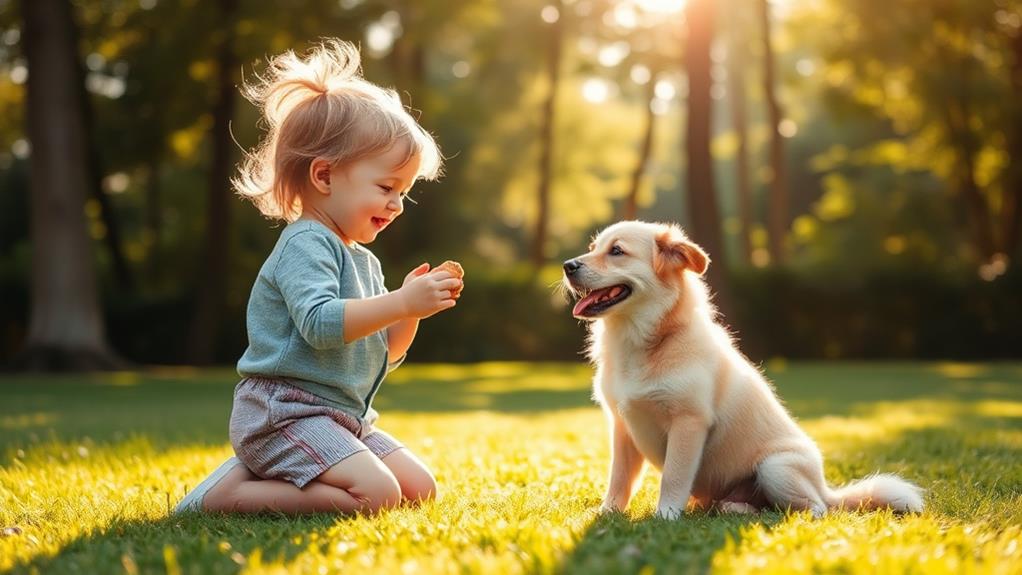To train your dog effectively with kids, start by understanding your dog's behavior and body language. Set clear training goals and involve your child in the process. Use positive reinforcement like treats and praise to encourage good behavior. Keep training sessions short, around 5 to 10 minutes, to maintain focus and enthusiasm. Incorporate fun activities like games or obstacle courses to keep things light-hearted. Teach basic commands consistently and practice patience. Celebrate small successes together as a family to build confidence. By fostering a positive environment, you'll strengthen the bond between your child and the dog while achieving training success. There's more to explore!
Understanding Your Dog's Behavior
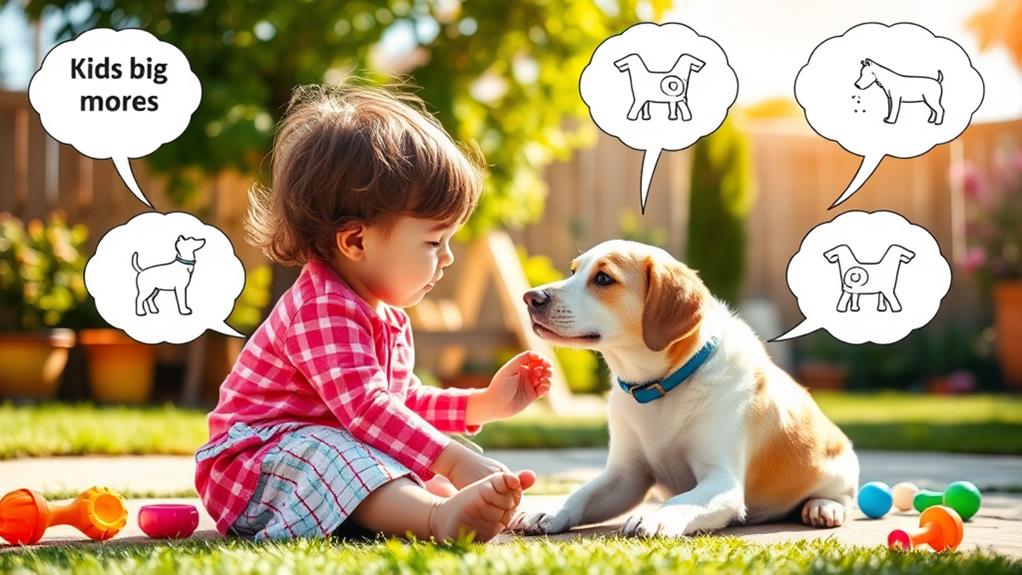
Understanding your dog's behavior is essential for effective training, especially when kids are involved. You need to recognize that dogs communicate through body language, vocalizations, and actions. Pay attention to their posture; a wagging tail usually indicates excitement, while tucked tails may signal fear or anxiety. When your dog growls or barks, it's trying to convey a message, so don't ignore those cues.
Consider your dog's energy levels and temperament, too. Some breeds are more energetic and require more exercise, while others might be more laid back. If your dog seems restless or hyperactive, it could be a sign it needs more physical activity or mental stimulation.
It's also important to understand how your dog reacts to kids. Some dogs love the attention, while others might feel overwhelmed. Teach your kids to approach dogs calmly, respecting their space. This helps foster a positive relationship between your dog and your children.
Lastly, remember that consistency is key. React the same way to your dog's behavior every time, reinforcing the right actions and redirecting the unwanted ones. By understanding your dog's behavior, you lay the groundwork for a successful training experience.
Setting Clear Training Goals
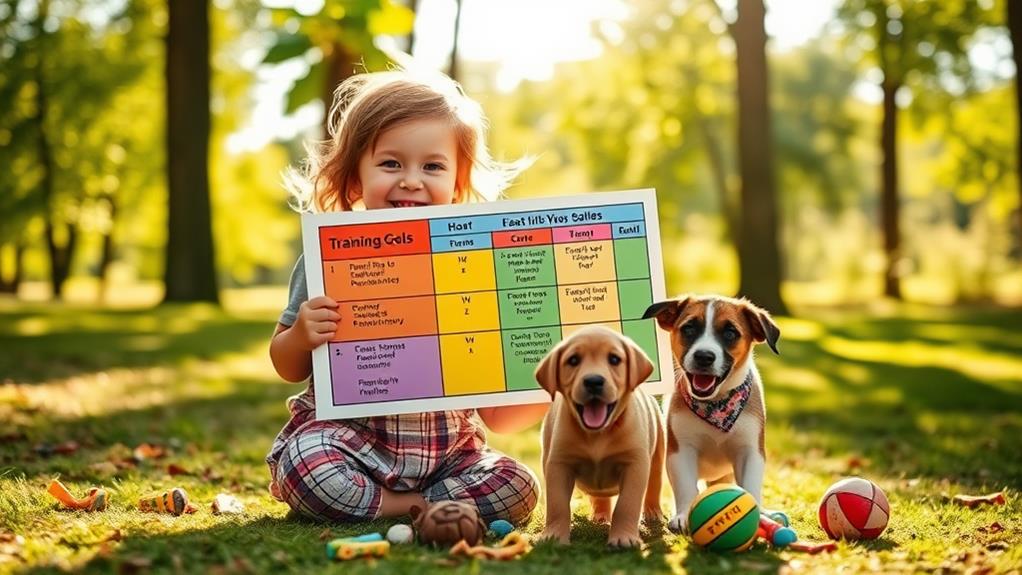
After you've grasped your dog's behavior, it's time to set clear training goals that guide your efforts. Start by identifying what you want to achieve. Are you aiming for basic commands like sit and stay, or do you want to address specific issues like jumping or barking? Make sure your goals are specific, measurable, achievable, relevant, and time-bound—often referred to as SMART goals.
For instance, instead of saying, "I want my dog to behave better," define it as, "I want my dog to sit on command within two weeks." This clarity helps you track progress. Once you've set your goals, discuss them with your kids. Involve them in the process; this not only empowers them but also makes them more committed to the training.
Next, break down each goal into smaller, manageable steps. This way, you and your kids can celebrate small victories along the way, keeping motivation high. Remember, it's important to be patient. Training takes time, and consistency is key. With clear goals in place, you'll have a focused path that leads to a well-behaved, happy dog and a rewarding experience for everyone involved.
Using Positive Reinforcement
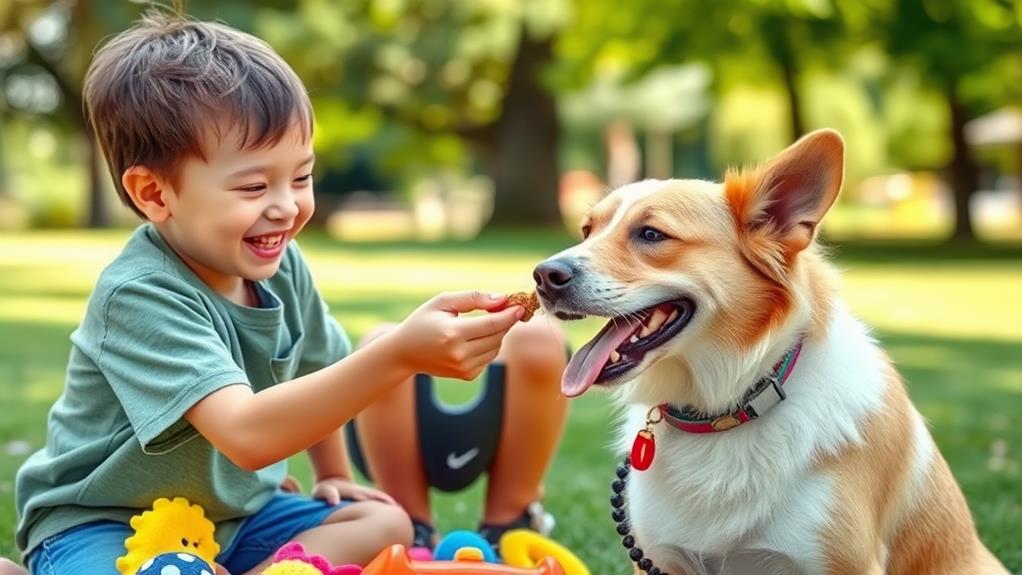
Positive reinforcement is a powerful tool in dog training that encourages desired behaviors through rewards. By focusing on what your dog does right, you'll create a positive atmosphere that fosters learning and strengthens your bond.
Use Treats: Treats are a great way to motivate your dog. Choose small, tasty rewards that your dog loves and can enjoy quickly.
Offer Praise: Verbal praise can make your dog feel appreciated. Use an enthusiastic tone to reinforce good behavior, like saying "Good boy!" or "Well done!"
Incorporate Playtime: Sometimes, a favorite toy or a game can be the best reward. Engaging in play lets your dog associate good behavior with fun.
Be Consistent: Consistency is key. Reward your dog every time they perform the desired behavior, especially during training sessions. This helps them understand what you expect.
Keeping Training Sessions Short
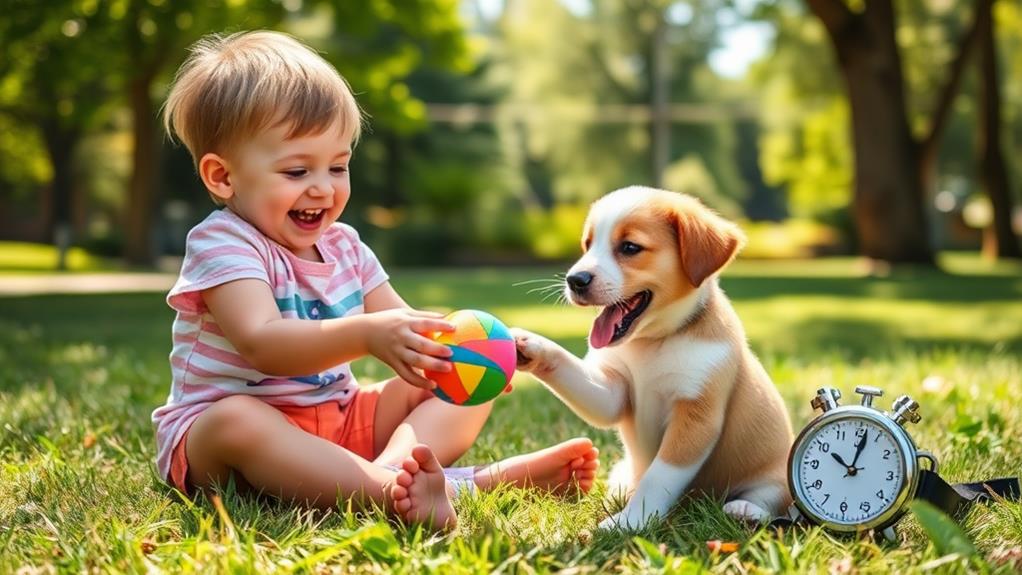
Training sessions should be engaging and fun, but keeping them short is indispensable for maintaining your dog's attention and enthusiasm. Dogs have limited attention spans, especially when they're excited or learning something new. Aim for sessions that last no longer than 5 to 10 minutes. This timeframe allows your dog to absorb what you're teaching without losing interest.
When you keep sessions brief, you'll notice that your dog stays focused and fervent for more. If you see signs of boredom or frustration, it's time to wrap it up. Ending on a positive note is pivotal; a successful session, even if short, reinforces your dog's willingness to learn.
Involve your kids in this process! They can help monitor the time and encourage the dog during training. Explain to them the importance of keeping it fun and light-hearted. Remember, consistency is key, so try to train your dog a few times a day, rather than in one long session. This approach not only makes training more enjoyable for your dog but also fosters a stronger bond between your child and the pet. Happy training!
Incorporating Fun Activities
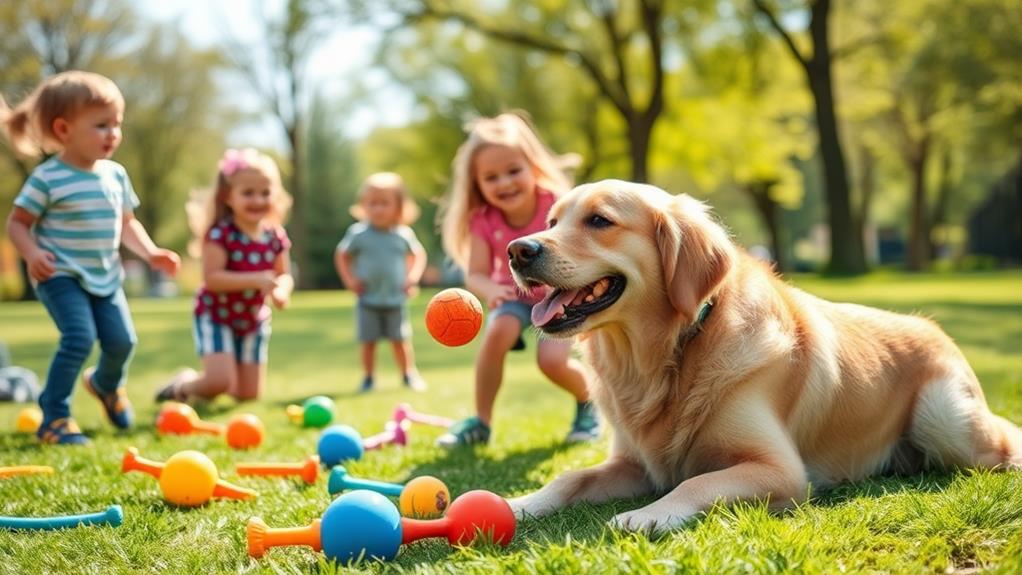
While your dog learns new commands, incorporating fun activities can keep the process enjoyable and engaging for both your child and the pet. Mixing in playtime not only reinforces training but also strengthens the bond between your child and their furry friend.
Some fun activities to ponder:
- Obstacle Course: Set up a mini obstacle course in your backyard. Use cones, hula hoops, or boxes for your dog to navigate through, making it a playful way to practice commands.
- Fetch with a Twist: Play fetch but add a command before throwing the toy. For example, have your child ask the dog to "sit" or "stay" before they launch the ball.
- Hide and Seek: Have your child hide somewhere in the house while calling the dog. This encourages the dog to listen and find them, making for a fun game.
- Trick Training: Teach your dog fun tricks like spinning or rolling over. Your child can take turns with you, making it a shared activity that brings joy to both.
These activities keep training light-hearted and foster a deeper connection.
Teaching Basic Commands
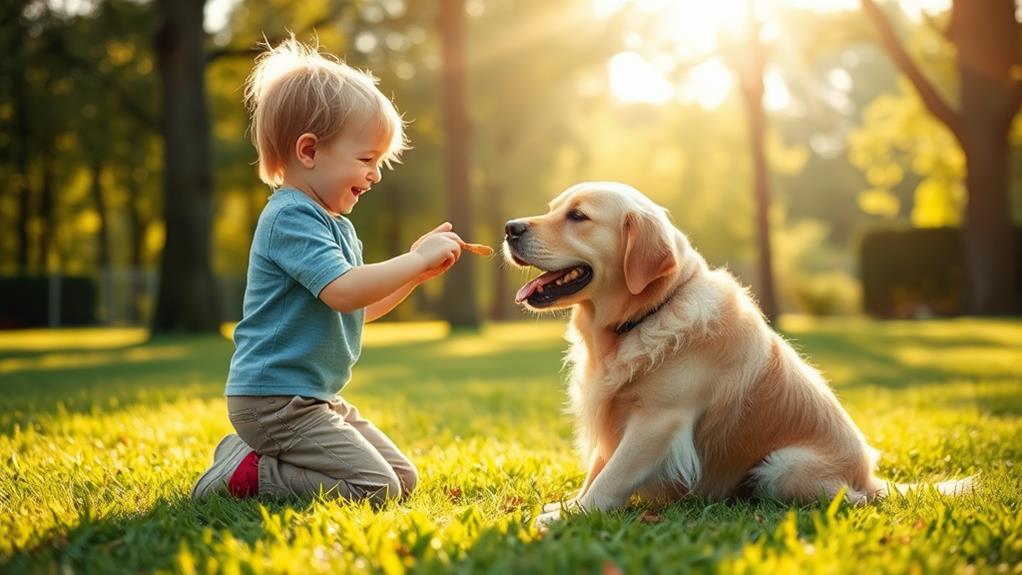
Teaching your dog basic commands is essential for building a solid foundation in their behavior and obedience. Start with simple commands like "sit," "stay," "come," and "down." These commands not only improve communication between you and your dog but also help keep them safe in various situations.
Begin with "sit." Hold a treat close to your dog's nose, then slowly move your hand up. As their head follows the treat, their bottom will lower. When they're in the sitting position, praise them and give the treat. Repeat this until they associate "sit" with the action.
Next, teach "stay." Ask your dog to sit, then show your palm and say "stay." Take a step back. If they stay, return and reward them. Gradually increase the distance and duration.
For "come," use a leash to guide your dog towards you while saying the command. Reward them when they reach you.
Practicing Patience and Consistency
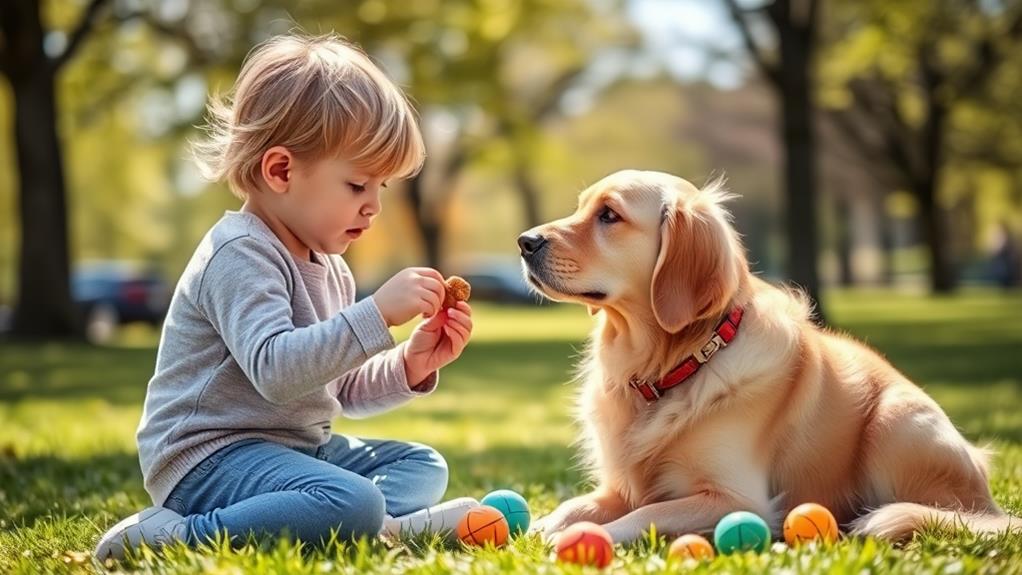
In the journey of dog training, practicing patience and consistency is key to success. When you train your dog, you're not just teaching them commands; you're also building a trusting relationship.
Dogs thrive on routine, and your consistent approach helps them understand what's expected. Here are some tips to help you:
- Set a Schedule: Choose specific times each day for training. This helps your dog anticipate and prepare for learning.
- Keep Sessions Short: Young dogs have short attention spans. Aim for 5 to 10-minute training sessions to maintain focus and enthusiasm.
- Use Positive Reinforcement: Reward your dog with treats, praise, or playtime when they follow commands. This encourages them to repeat the behavior.
- Stay Calm and Composed: If your dog isn't getting it right away, don't lose your cool. Take a deep breath, stay positive, and try again.
Involving the Whole Family
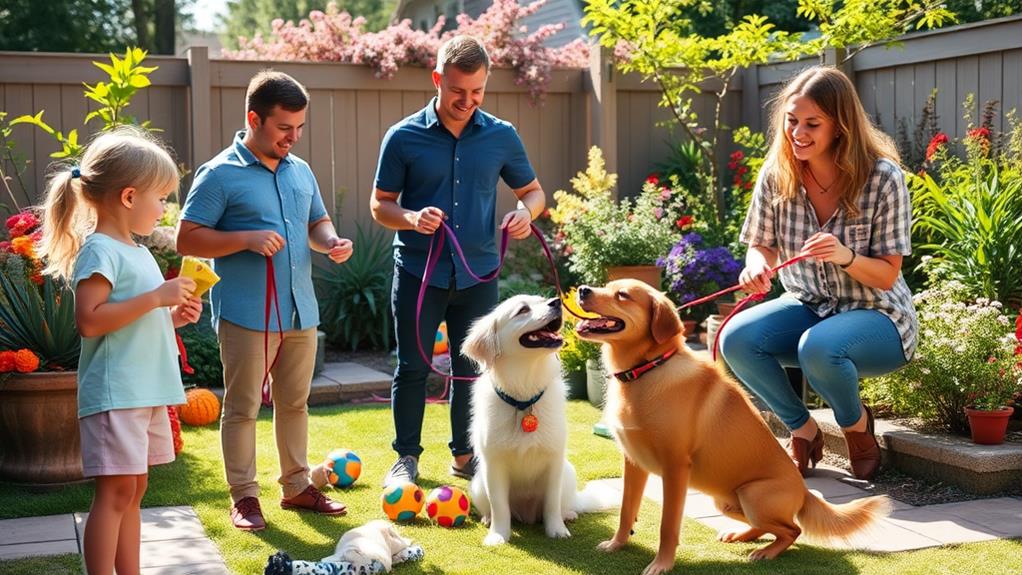
Getting the whole family involved in dog training not only makes the process more enjoyable, but it also strengthens the bond between your dog and each family member. When everyone participates, your dog learns to recognize different voices and commands, enhancing their responsiveness.
Here are a few ways to involve everyone:
| Family Member | Training Activity |
|---|---|
| Kids | Teach basic commands like sit and stay. |
| Parents | Practice leash walking and socialization. |
| Grandparents | Reinforce positive behaviors with treats. |
| Siblings | Engage in play sessions to build rapport. |
| Everyone | Hold group training sessions for consistency. |
Celebrating Training Successes
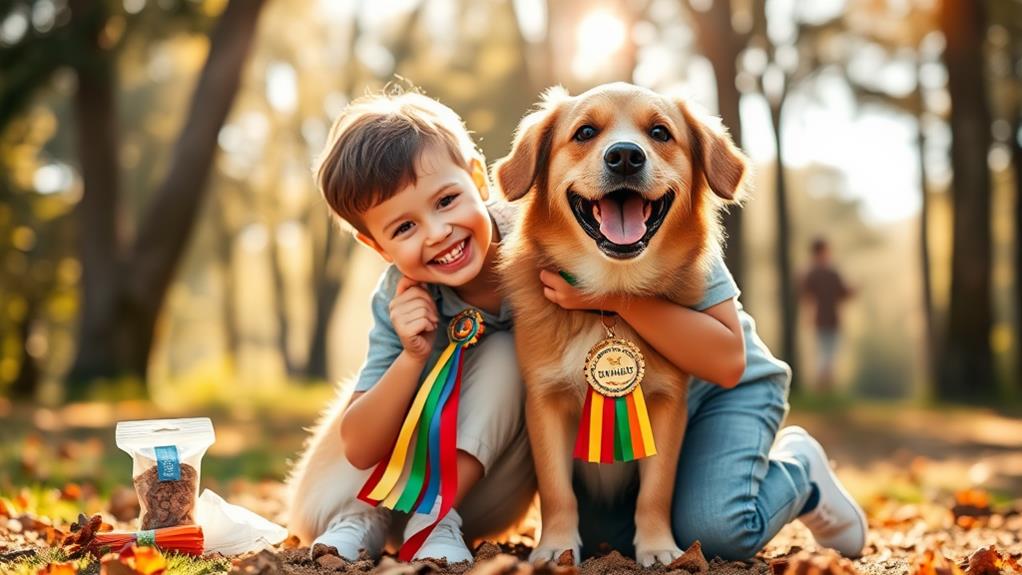
Celebrating training successes is crucial for keeping your kids motivated and engaged in the process. When your child sees the positive impact of their efforts, it boosts their confidence and strengthens their bond with the dog.
- Verbal Praise: Always start with enthusiastic words of encouragement. A simple "Great job!" goes a long way in making your child feel proud.
- Small Rewards: Consider offering small treats or toys as rewards. It doesn't have to be extravagant; even stickers can make a big difference!
- Training Journals: Create a training journal where your child can document their dog's progress. This visual representation of success reinforces their hard work.
- Celebrate Together: Host a mini celebration after achieving a significant goal. Invite family members to join in, making it a fun event that everyone can enjoy.
Frequently Asked Questions
What Age Is Best for Kids to Start Dog Training?
The best age for kids to start dog training is around six or seven. At this age, they can understand instructions and handle basic commands, making it a fun and engaging experience for both.
How Do I Handle a Dog That Refuses to Obey?
When your dog refuses to obey, stay calm and patient. Use positive reinforcement to encourage good behavior, and try different commands or rewards. Consistency is key, so keep practicing and don't lose hope.
Can Small Children Train a Dog Effectively?
Sure, small children can train a dog effectively—just like you'd let a toddler steer a car! With guidance, patience, and simple commands, they can bond with and teach their furry friends valuable skills.
What Should I Do if My Dog Is Aggressive?
If your dog's showing aggression, stay calm and avoid confrontation. Identify triggers, create distance, and redirect their focus. Consider professional training or behaviorists to guarantee safety for you and your dog's well-being.
Are Certain Dog Breeds Easier for Kids to Train?
Imagine guiding a young artist with a vibrant palette. Some dog breeds, like Labrador Retrievers and Golden Retrievers, are more keen to please, making training smoother for kids. You'll find joy in their quick learning!
Conclusion
Incorporating these dog training tips not only helps your child bond with their furry friend but also builds essential life skills. Did you know that kids who engage in pet training develop better empathy and responsibility? By setting clear goals, using positive reinforcement, and keeping it fun, you'll guarantee a successful training experience for both your child and dog. Remember, patience and consistency are key, so celebrate every small victory along the way!

